Lesson F QUESTIONS |
Lesson Index A thru F
Lesson F:
Religious Practices of the Pre-Christian &
Viking Age North
by Alfta Lothurrsdottir
Northvegr.org ©
2006
Modern Practice
Introduction
Now that we have examined the practices of pre-Christian and Viking Age Heathens the question some might ask is why should we seek to emulate them in their religious practices? The simple question is because we at MSR consider ourselves to be a reconstructionist tradition. The more detailed answer is that we believe when we make the extra effort to go through the same motions our ancestors did we establish stronger connections with our ancestors. The Christian religion has cut us, as a people, off from the flow of othr that flows from our ancestors to us and from us to those who will follow in a great ring. By reclaiming the way of our ancestors we work to reopen that flow that has lain fallow for a thousand years. By conducting the blót (strengthening) we open our ears to the whispers of the our ancestors and to the whispers of our gods and goddesses. We seek to emulate their actions to strengthen the bonds between ourselves and our ancestors and our gods and goddesses.
The next question then is how do we take these practices and incorporate them into our modern day practice. How each of us honor our ancestors and the Regin is a deeply personal issue. It is not one that should be dictated. Only each person can decide for themselves what is the proper way to honor the ancestors and the Regin. So what I present here are suggestions; suggestions based on the lore we have left to us and on personal practice and experience. I have labored very hard to present as many legitimate sources from the lore as possible so that each person can read them and decide on their own how they should be used. The most important thing is that you DO. How you choose to strengthen the bonds of kinship with your ancestors and the Regin is not as important as DOING it. I cannot stress that enough. So read on and please feel free to contact with your ideas and observations. I am fully aware that I may miss an important observation and would be glad to hear about it if I have. It is, above all important, that the reader will take what I have presented here and use it to strengthen the bonds between themselves and the their ancestors and the Regin.
The Sacred Enclosure
As we have seen the variety of sacred enclosures is quite high. They included sacred groves, sacred fields, sacred stones, hills and mountains, springs, waterfalls as well as built structures. What you use for your sacred area will depend on what you have available. Not everyone has access to wilderness areas. In this case a personal stalli can be set up in a corner of a room. This stalli could be as simple as a table on which you set your sacred instruments and any images or symbols you wish to use to represent the Regin and/or your fulltrúi. The stalli should be oriented in such a way that you when you stand before it you are facing north. The northward direction was considered as holy so any sacred act should be done facing north.
Some might wish to set up a hörg in their back yard and again this should be oriented in a north-south direction so that when standing before it to perform a blót you are facing north. For those who have access to more rural settings or can build their own hof so much the better. The main emphasis is to set an area apart that was considered sacred. This area should not be used for anything other than the blót. Even if we are talking about a small stalli in one corner of your room, that table should be used only for the purpose of your blót. I have such a stalli in my living room and I do not set anything on it even for a moment unless it is the instruments and symbols I use for my blóts. I do not do this out of fear but out of a desire to show respect for my ancestors and for the Regin.
Rules for Sacred Ground
When treading on sacred ground there were certain rules that were observed. We know that no one was allowed to look on (pray to) the holy mountain at Helgafell without being washed so we would not be remiss in saying that a person should wash before entering holy ground. We know that salt and salt spring were considered holy so the taking of a ritual bath with salts would be completely within a Heathen framework. We know also from the Old Norse word blótkæði (garments worn at sacrifices) that there was a special name given to clothing worn to blóts, so special clothing that is worn only at blóts would be something to consider as well. This clothing need not be Viking Age period garb, though some may choose that. It could be modern clothing as well. The emphasis should be on clothing that is only worn at the blót. I have an amber necklace and an amber ring that I wear only during blóts. Anyone who knows anything about ritual knows that drama plays an important part in the rites and having special clothing or items that one wears only to blóts helps one get into the proper state of mind. Of course this isn’t something that has to be done but it can only add to the rite. We also know from Grimm that no covering should be worn on the head.
Probably one of the most important rules concerning sacred ground was the prohibition against violence of any kind on sacred ground. The person who violated this law was called varg í véum (wolf in the enclosure). I think it would be safe to say that, barring the Thing (legal assembly) disputes of any kind should be saved for another time. The purpose of the blót is the strengthening of bonds and this is a time when the chaos that can result from disputes should be avoided at all costs. Another rule closely related to this is the prohibition against bringing weapons onto sacred ground. These two prohibitions seem to have been universal so the following of these two prohibitions are definitely two we should be following.
Lastly comes a matter of a practical nature. We saw that a place to answer the call of nature was to be provided just off the sacred ground. Defecating or urinating on sacred ground was one of the prime ways of defiling it. The call of nature should never be answered on sacred ground.
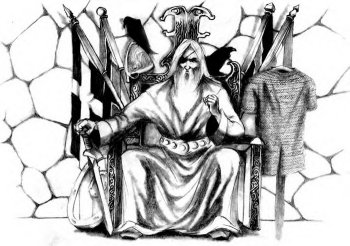
Images of the Gods and
Goddesses
TOP
(To Read this last section with the Rune images showing,
click
here. To read it while seeing some pictures, don’t click, but stay on
this page!)
We know from Tacitus that the Germans around the 1st centuries C. E. did not have images of their gods and goddesses. They considered it unsuitable to depict them in human likeness. Despite this we know they did eventually develop the practice of depicting the gods in human form. This may have developed from contact with the Romans who we have many fine examples of their gods and goddesses being depicted in human form. My own choice in this matter is to not depict them in human form but to use their symbols instead. This could range from animals associated with them to runes, and other similar symbols. This in no way should be taken as the recommended course to take. Each person should decide this matter on their own. I simply offer the course I personally will take. I would like to offer, then, some suggestions for symbols relating to various of the Regin, including the runes associated with them.
Othinn: Valknot; This should never be worn or tattooed oneself unless you are willing to offer you life up at his whim. Ravens; His two ravens Hughinn and Munnin. Wolves; His two wolves Geri and Freki . The Spear; His spear Gungnir. Also the spear was thrown over ones foes to dedicate (sacrifice) them to Othinn. The eagle; Othinn was known to turn into an eagle. a o
Frigg: Keys; Frigg was considered patron of the household and in Old Norse tradition the new wife was given the keys to the house as a symbol of her control of that aspect of life. The spinning wheel; Frigg was connected to spinning. b z
Freyr: The horse and the boar; Both animals were strongly connected to Freyr and the boar was his symbol both for war (its fierceness) and fertility. There are mentions of horses dedicated to Freyr and also of sacred horses that were kept on the land adjacent to hofs dedicated to Freyr. Freyr also had a golden boar named Gullinborsti. q
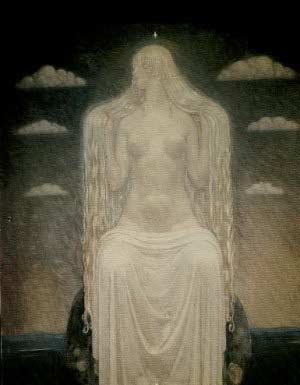
Freyja: The Falcon; Freyja had a falcon cloak which Loki borrowed on occaision. The boar and the sow; Freyja like Freyr had a golden boar whose name was Hildisvini and one of Freyja’s many names was Syr which means ‘sow.’ The sow was a major symbol of fertility. The cat; Two cats are said to pull her wagon. The swastika; This symbol is usually connected with Thorr but I would submit that it belongs more properly with Freyja. It is a cyclic symbol and female statues have been found with the swastika drawn over their reproductive area. This shows that it was considered a fertility symbol and its revolving nature shows the possibility of a cyclic symbol, all of which would have been under the aegis of Freyja. The ladybug; The ladybug was thought to be sacred to Freyja.
Thorr: The hammer; The symbol of our tradition as well as a symbol of Thorr. It is used to hallow and represents his hammer Mjollnir. Goats; Two goats, named Tanngnostr (Teeth-grinder) and Tanngrisnir (Teeth-bearer) pull Thorr’s wagon. Oak; The oak tree is sacred to Thorr. The Stag beetle; The stag beetle was thought to be sacred to Thorr. Rowan tree; This tree is also sacred to Thorr. x
Loki: Fire/flame; Loki’s powers are related to fire. c
Ullr: The bow and skis; Ullr is connected strongly with both of these and said to be the best shot with the bow. i
Baldr: The ring; Baldr was given the ring Draupnir by Othinn. s
Njorth: The ship; Njorthr’s hall was called Noatunn (ship yard) and he was prayed to by those who made money while using ships (merchants). The Foot-print; Njorth has the most beautiful feet of all the Regin. l r
The Vanir: The wagon; The wagon is a symbol of the Vanir in general.
The Nine Worlds: A large old tree; The nine worlds are symbolized by the world tree, Yggdrasill. The tree is usually depicted as an ash or yew.
Ithunn: The apple; Ithunn cares for the apples of immortality which the gods and goddesses use to keep themselves young.
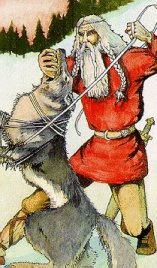
Tyr: The North Star; The North Star is connected to Tyr. The Irminsul or Universal pillar; This is associated with Tyr. t
The Mead of Poetry: The Cauldron; Mead was made and served in cauldrons in the old traditions. This also symbolizes the pact made between the Aesir and Vanir which has never been broken.
Ran: The net; Ran was said to have a net in which she caught up those who drowned.
Aegir: The cauldron; The cauldron might also be a symbol of Aegir because he was a great brewer of mead. p
Sif: Golden wheat; Sif’s golden hair is often equated with wheat. b
Vitharr: A shoe or boot; Vitharr will avenge the death of his father Othinn by kicking to death the Fenris wolf with a strong boot or shoe that he has. y
Mani: The moon; Mani is the god of the moon. m
Sunna: The sun; Sunna is the goddess of the sun. Solwheel (Swastika); A symbol of Sunna. Solcross; Another symbol of Sunna. s
Heimdallr: The horn; Heimdallr will blow his horn at the approaching of Ragnarok. Sheild; Heimdallr’s jog is to guard or shield the bridge Bifrost from the frost giants. h d
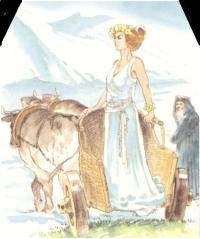
Nerthus: The wagon; Her rites included the procession of a sacred wagon. j
Rinda: The rune isa i .
Var: g
Gefjon: g
Hermothr: d
Eir: q j
The Wild-fire
The wild-fire (need-fire) was the most holy form of fire and it is suggested that whenever possible to use fire started from a wild-fire, that is, started from friction caused by the rubbing together or two pieces of wood. In on description of the need fire we saw that those making it removed articles of metal from their self before starting and I would suggest that this be done for your wild-fire as well. Creating wild-fire is no easy task, especially if one has no experience with it, so if you decide to use wild-fire for your next blót be sure to practice it ahead of time. In any case, however you get the fire started, you should always have fire in your blót even if it is as simple as lighting a single candle. Fire carries your words and your offerings to the other worlds.
The Blót-feast and the Full
The blót-feast is the major religious observance in Regintroth. It is our recommendation that the full blót-feast be conducted at least twice each year, on Midsummer and Jól. It is, of course, all right to conduct blót-feasts more often. As we established before, the blóts primary purpose is the strengthening of bonds, both between kin and between us and the Regin. The blót also serves to keep us connected with nature, as we know our Heathen fore-fathers were. In these modern days, where most of us may not be dependent on the land, and its bounty, it is even more important to observe the turning of the seasons so that we can stay in sync with nature. I would like to now discuss some ideas on how we might conduct a blót-feast from a practical standpoint as opposed to the more esoteric and/or spiritual reasons. We might break the feast-blot into five major sections. These sections would be the procession, the offering, the celebration, the feast and the full. I’ll discuss each one in turn.
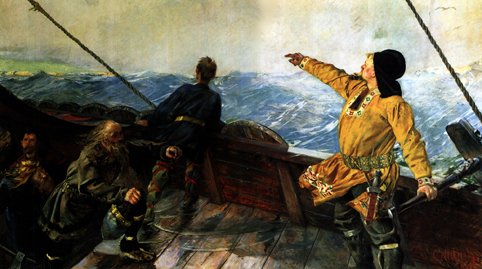
The procession: I happened to be flipping around the channels on TV one day when I happened across a documentary on Leif Eriksson. This was an older documentary that was, from the appearance, from the 70’s or 80’s. Part of the documentary centered on the reclaiming of the Heathen tradition by Icelanders. They profiled the man responsible for getting Heathenism recognized as an official religion in Iceland, Sveinbjorn Beinteinson. They filmed a blót which he conducted which was quite moving and impressive to see. The blót began with a procession. Sveinbjorn was in the lead in white robes and he as well as others carried various standards as they made the trek up the holy mountain where the blót was to be held. It was a stately and solemn affair. We know from sources in the lore that this practice was often used in one way or the other especially in Vanir rites. A procession, in which standards and the tools of the rite are carried to the sacred area can serve very well to get the participates in the right frame of mind for the rite. Chants and songs which we know were done on processions can also serve to enhance the experience. The procession’s purpose should be viewed as for preparing the minds of the those participating for the blót.
The blót: This is where the offerings are made. Animal sacrifices would be done here and the blood sprinkled on those present. Other offerings would be left at this time as well. Other than that we don’t know much about how the blót was conducted. We, at MSR, have chosen this time to perform what we call the blót-full (strengthening toast). This is a toast in which the participants strengthen the bonds between them and their ancestors and the Regin.
The Celebration: At this point in the blót the participants gather together and celebrate. This could include dancing, singing, story-telling and competitive games. These activities may vary depending on the purpose of the blót-feast. For instance, during the Midsummer blót-feast it was traditional to build a great bonfire and for the youth and any others that would venture it, to jump over the fire.
The Feast: The feast was a time of joy and fellowship. The animal that was sacrificed was cooked and everyone enjoyed a sacred meal in which it was considered that the participants were taking part in the meal with the ancestors and the Regin. The meat was boiled in a kind of stew in cauldrons and the mead was served from cauldrons as well. Everyone should give the first portion of their food to the fire (or in a container to be taken later and burned outside or left at the food of a tree) in honor of the Regin and the Ancestors. Although animal sacrifice is still viable in my opinion, most people will not have the skills or means to do so. Animals sacrifices should be done only by those skilled in the methods that will bring the animal’s life to an end as quickly and as painlessly as possible. Also needed would be someone who knows how to butcher an animal properly and there might be city, state and county laws that apply as well. Everyone participating in the blót-feast should contribute food and drink toward the feast and this will, of course, require prior planning. I think it would be good, if possible, to have a cauldron to keep the mead in (or whatever you use for the sacred drink). The feast should continue until everyone has had their fill and the feast-jarl calls for the full.
The Full: The full consists of five specific toasts and then an unspecified number afterwards. The first five are, Othinns-full, Freyrs-full, Njorthrs-full, the Braggi-full and the minni-full. The feast-jarl as the right to call for the full. He calls for it and hallows the mead. Then he begins with Othinns-full which is a toast to honor the chief of the tribe of the Regin. Each person starting on the feast-jarl’s right honors Othinn with a toast until all have done so. Then the feast-jarl will begin the next full and it is conducted in the same manner for each full. Freyrs-full is a toast given in honor of Freyr for peace in the coming season. Njorthrs-full is given for prosperity in the coming season. The Braggi-full is a toast in which the person either boasts (brags) about a previous oath completed or makes a solemn oath to complete some task. And finally, the minni-full is given to honor one’s ancestors and friends that have passed to the other worlds. These fullar could go on for some time and include multiple rounds of toasts.
The Solemn Oath
I feel I should speak a little on the solemn oath. Contrary to the way some would picture the oath, the oath is not every statement that comes from one’s mouth. Saying you will meet someone in one hour is not an oath. Giving your word is not an oath. Although you will certainly suffer a loss of reputation from breaking your word it still is not the same as a solemn oath. A solemn oath is sworn to the gods themselves and is a spiritual action. The solemn oath is a formal statement, the swearing of which affects your orlog. It always has profound effects on your life. Whether or not these effects are beneficial or detrimental all depends on whether or not the oath has been fulfilled or not. Great care should be taken before swearing a solemn oath because you will be held to it by the forces of wyrd. Never ever swear an oath unless you fully intend to fulfill it, because no matter how rash it was, you’ll be expected to fulfill it. Stories abound in the lore of people taking rash oaths and having to fulfill the oath even though it might cause their death. I cannot stress this strongly enough. Those who swear solemn oaths lightly and break them just as lightly are, to put it in the vernacular of my homeland, in for a whole heap of trouble. Take as much care in swearing a solemn oath as you would in fulfilling it. I give this caution here because I think it is something that is important to keep in mind while drinking the fullar. The Braggi-full includes the swearing of solemn oaths and each person should keep these cautions in mind because the drinking of mead has caused many a person to act rashly.
Offerings
The types of offerings given were many and varied. What seemed to be the case was that it was not so much important what was offered as much as it was that what was offered was valuable to the person offering it. Everything from fruit, bread and clothing to gold, weapons and animals were offered. But the one thing that was common among them all is that they were considered of worth by those giving the offering. While a loaf of bread might be considered a good offering for a poor farmer to make, it might be considered an insult to the gods for a wealthy jarl to offer the same. Offerings were often thrown in lakes, bogs, pools, springs or waterfalls. They also were commonly left at the foot of trees or holy objects such as sacred stones. Offerings were also made by throwing them into a fire. Only animals that were eaten by man were considered as worthy to offer the gods. So in modern practice we could say that the most important aspect of the offering should be that it holds value to the person giving the offering. Don’t offer something you do not personally value.
Hallowing
A few different methods can be used for hallowing. Any object or land could be hallowed simply be dedicating it to one of the Regin. This could be done at a special blót for the purpose. Using a hammer or the sign of the hammer can be used as well. Fire was also used as we saw from accounts describing how it was used to hallow the mead drank in the full by passing the mead either over or around the fire. In descriptions of blótar we know that the blood of sacrificed animals were used to hallow the hof, instruments and those participating in the blót by sprinkling the blood on them with a tine or twig. We might consider a similar use of the hallowed mead.
When to Blót
One of the hallmarks of Heathenism is its connection to the land. The Heathen lived in cooperation with the cycles of Nature. He did not attempt to control nature or see it as something evil to be overcome. In modern times we can easily get out of sync with nature. We no longer need to depend on Mother Nerthus for food or for the hunting of animals. We need only go to the local supermarket. Observing the major tides is a way we can reconnect with nature. Even though, for my reconstructed holy night calendar, I list specific dates for the blótar I suggest that each person try to use the actual tides to decide when a blót should be held as the Northern Europeans once did. The summer finding blót could be held when the first flower blooming is spotted or when the a migratory bird makes its first appearance after returning from its winter time roost. Winter Nights could be conducted when the last leaves have fallen from trees. We also know that the phase of the moon was always an important consideration for when blótar were conducted.
More practical considerations sometimes come into play as well. Sometimes it may be better to delay a blót for a few days so that it can be held on a weekend, when more people will be able to attend. It is also likely that our Heathen ancestors gathered together more often than on the major tides, perhaps monthly on the full moon, and we know that they also held blót-feasts for special occasions such as marriages and births.
Blót Activities
Many times there were other activities at blóts. Singing, dancing, story-telling and games were some of the activities that are attested to in the lore. Specific blóts sometimes had specific activities that were associated with them, which I’ll talk more about in the blót instructions for those specific blóts. We should feel free to improvise these activities because, in essence this part of the blót-feast was always about kin getting together and having a good time. This would be a great time for story-telling. Stories from the Sagas and the Eddas could be told in such as a way that they relate the values that Heathenry holds as desirable in order to teach them to the young ones. In times of old, it was the one of the best ways to teach the young what ideals they should value. This was one of the most important aspects of what the skalds did. They used their stories to relate these values and reinforced them upon the whole culture. This is a tradition that we modern Heathens should work hard to revive. The power of story to teach and reinforce our values while at the same time entertaining should not be overlooked.
Conclusion
I think I have shown that contrary to popular opinion, there is quite a bit of material to be found concerning the traditions of our Northern European ancestors. If one looks hard enough they can find many many pieces to the puzzle that was the religious practices of Heathenry. Although I gathered almost 200 pages of notes which translated into nearly 80 pages of article I, by no means, exhausted the store of information that is out there waiting to be collected. Although I did not find all the pieces of the puzzle (we are unlikely to ever find all the pieces) , I do believe that I found enough to get a good picture of what the true practices of Heathenry were. I believe that there is enough here for us to take up and rebuild genuine Heathen custom. In Regintroth: A Book of the Northern Way, I’ll offer guides for these rebuilt customs, but it is my hope that the reader will take this information I have gathered and use it to build their own traditions. It is my hope that these traditions will be passed down from father to son, from mother to daughter just as they were in times of old. We modern Heathens have been cut off from the ways of our ancestors for a century by the religion of the desert god. It is time now that we take back the ways of our fore-fathers. If this article helps one person do that, then I will be satisfied that the considerable effort I expended to research and write this article will have been well worth it.
Lesson F
QUESTIONS (by Lady Arianna aka Donna K.) Top
Send your answers to the following questions
in an email with the subject line: “Teutonic Religious Practices Lesson F from _______ “
1. Do some thinking about “holy enclosures”and tell us are they still practiced by you and where they exist in your present home today. Send in your report.
2. How might rules for holy ground still be incorporated in today’s society? Explain your thoughts.
3. Fill in the blanks: The most important rule concerning _______ __________ was the prohibition against violence of any kind on holy ground. The person who __________ this law was called varg í véum ( ______ in the enclosure).
4. List five gods and their associated Rune symbol. Explain their meaning as per the author’s determination.
